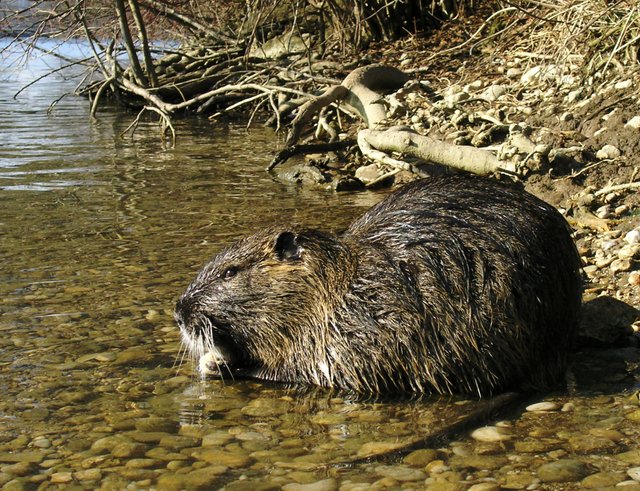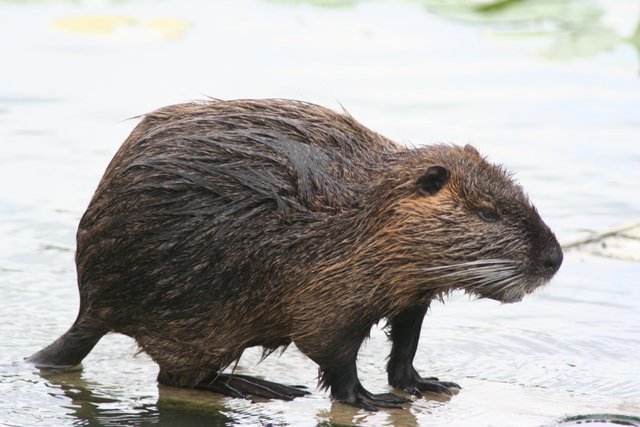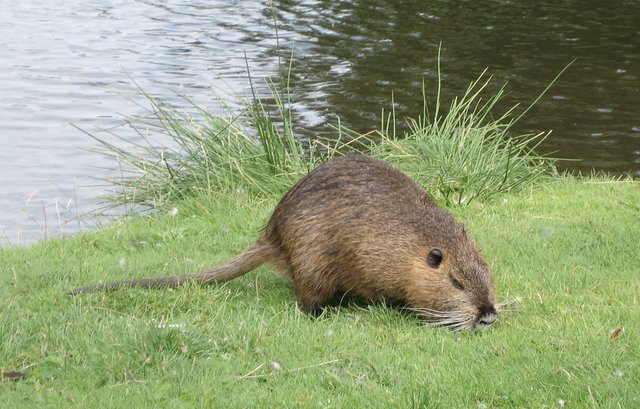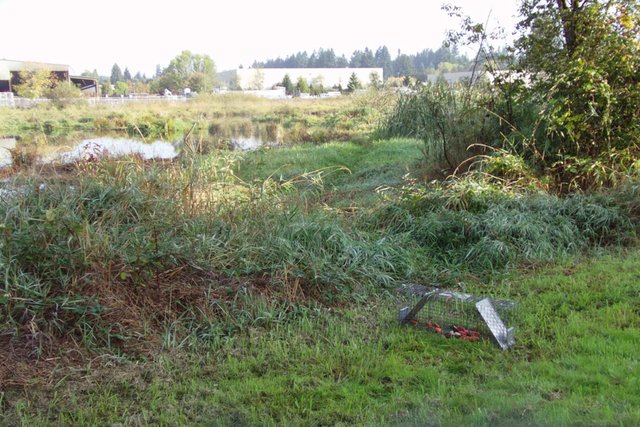The nutria (Myocastor coypus) is invading Californian wetlands, and could cause havoc for this intricate ecosystem!
The nutria (Myocastor coypus), also known as coypu in South-America is a large, semiaquatic rodent that looks a lot like a beaver. It is the only extant species of the Myocastor genus, a name that can literary be translated to read “beaver rat” if you translate Myocastor from Latin to English. If you wonder why, just look at it. It looks a lot like a beaver, but the tail looks like the tail of a rat.

It really does look like a beaver as well. Image by Petar Milošević, posted with the Creative Commons Attribution-Share Alike 3.0 Unported license.
The nutria can weight up to 10 kilograms / 22 pounds, live up to 10 years (but the average life span is closer to 3 years), and tend to thrive in small colonies in freshwater mashes, but can at times also be found in brackish marshes. Like other rodents, they are able to breed very rapidly, and a single female can produce three litters each year. While most offspring die young, a single breeding pair can end up with building a population of 16,000 animals after only three years, given that their offspring keeps breeding, so this species has the potential for exponential growth once they settle in a new area.
The nutria is originally endemic to South America, but was released to California in 1889 in order to breed for its fur. Once the fur market collapsed in the 1940s, thousands of them were released into the wild when the farmers could no longer afford to keep and keep them.

Image by Philippe Amelant, posted with the Creative Commons Attribution-Share Alike 3.0 Unported license.
This of course ruined many marshland ecosystems in the United States, and they quickly spread over the US. The population that appeared in the 1940s eventually got (mostly) taken care of, but there are still some places that have them. The population in California mostly disappeared, but now it has returned, and no one know how or why!
And to us Europeans; it got released here as well, and it can still be found in many parts of Europe and Africa. We luckily don't have it here in Norway, but it's found in places such as France, Russia, and Germany.
The nutria is back in California!
During the last year over 20 different nutria has been spotted in freshwater habitats in California, and the California Department of Fish and Wildlife has no idea how they got there. The 20 different animals that have been observed includes both males, females, offspring and juveniles, so it’s safe to assume that a breeding population is settling in.

Image by Henri Sivonen, posted with the Creative Commons Attribution 2.0 Generic license.
The California Department of Fish and Wildlife Agency is getting really concerned, and has even set up a hotline where people can call if the spot a nutria in California. It will be exciting to see if they are able to get the population under control before it breeds into large numbers and destroy more ecosystems.
Why having nutrias in California is bad news for the ecosystem
While the nutria is a cute animal, it can have devastating effects on the ecosystem. Keep in mind that it lives in or close to wetlands, a type of ecosystem that is generally considered very fragile. When nutrias enter the ecosystem, they begin to forage the plants in the area, and a single nutria can eat as much as 25 % of its own weight every single day.

A nutria cage set out by the U.S. Fish and Wildlife Service. Image is Public Domain.
Most ecosystems are not capable of dealing with this huge loss of biomass every single day, and the result is that the wetland ecosystem begins to shrink in size. Once the main vegetation begins to disappear, the nutrias begin to dig for roots and rhizomes in order to feed on these, which causes further long-term damage to the ecosystem.
Wetlands is considered to be a very important ecosystem both by animals and humans. Not only does it provide a unique biotope that is inhabited by many interesting species, it is also providing cleaner water, storm surge protection, filtration of chemicals, and flood control, so it has a big economic impact as well.
Other posts about invasive species
Want to learn more about invasive species? Then just follow the links to keep reading!
- The American mink (Neovison vison) is found in almost all parts of Norway (and in many parts of Europe as well), and has spread from captive fur minks that have escaped their cages.
- Red foxes (Vulpes vulpes) were introduced to Australia for sport hunting in the 19th century, but ended up being responsible for the extinction of several native species, including the desert rat-kangaroo (Caloprymnus campestris)
- An invasive Asian carp species has been found just 9 miles away from Lake Michigan!
If you just like to read about huge rodents, then these posts might be interesting to you:
- The reintroduction of beavers (Castor fiber) in England has been a success; they protect the nearby areas from food and soil erosion, as well as provide the area with a thriving ecosystem.
- The world’s largest rodent, the capybara (Hydrochoerus hydrochaeris) have been imported to Japan to relax in Japanese hot springs!
Thanks for reading
I hope you enjoyed the post about the nutria/coypu. If you went to learn more about this big rodent, then I suggest that you follow the links in the text!
About @valth
Hey, I'm @valth - the author of this post. I love to write about nature, biology, animals, nature conservation, ecology and other related branches of science, and I occasionally write about my life, about Steem or about random stuff as well. I'm trying my best to write at least one post every day, so make sure to give me a follow if you enjoy my content and want to see more of it.
Join the @valth community!
I love nothing more than to engage with my readers, so please join the @valth community in the comment section. You will definitely find more information about the topic, personal experiences, questions, and even opposing views down there, so don't miss out on learning more.
I always reward users who post good comments, so please take the opportunity to share your views and get a small upvote in exchange for it.
This is a test comment, notify @kryzsec on discord if there are any errors please.
Being A SteemStem Member
With a life expectancy of 36 months, 16,000 number is un believable. Excess of every thing is bad. Again we blame ourself for the damage in California by introducing Nutria cage. Same as red foxes in Australia. Actually we don't make responsible any one as some time these experiments work for us. Some time they don't. The important thing is we should take advantage of these studies to make better eco system. It is possible only by giving awareness and truly act upon the New findings of science
Wow 16000 over 36 month life expectancy!!
Thats about 444 per month?? That doesn’t sound possible to me. How did they calculate that?? Is that offspring of offspring of offspring?
I believe its a delicacy in South America.. i guess you could say it was a sustainable source of meat if they produce so profusely :-)
Hi, @robmenzies.
You are of course right; they cannot possibly have over 400 offspring every month. It is like you said, where the offspring breeds with itself, the next generation breeds with itself etc. This gives us an exponential growth that ends up with 16,000 animals after three years. I'm not sure if the number is realistic or not, but it is provided by the US fish and wildlife agency, so it is an official government statement, so take it as you will :)
Thanks for pointing this out by the way! I edited the text to make it more clear that the 16,00 babies are not all born from a single mother.
It's cool to hear that it's a delicacy! I'm sure it's pretty sustainable. I've heard some ecologists argue that we should be shooting beavers for food here in Norway, but the culture here never really adapted to that, so it's a really niche type of meat. I guess they both reproduce easily and are easy to shoot, so why not? :)
I actually first learned of these from a segment (~ 9 mins in) on a comedy/travel show in which Dave Attell (US comedian) went along with with a nutria removal crew.
That was shot in Louisiana, where they were introduced not only for the fur, but also because their voracious appetites were used to control plant growth in canals and bayous.
There's actually a bounty on them at times (only about $4 each), but at least one guy has made tens of thousands of dollars hunting them.
Thanks for sharing the YouTube clip with us :) As you said, they are found in more parts of the US, and I'm sure whoever had the brilliant idea of releasing them in order to control plant growth is regretting it pretty badly at this point. It never really works out when we try to introduce a new species to solve an issue.
It's really cool that there's a guy who have made so much money from hunting them. $4 per tail is not really much, but I guess he is able to kill a lot every day then.
He turned in 9000 one time. The reward is about the same as STEEM right now, and you've certainly witnessed what lengths people will go to for that. ;)
Haha, that's a good point! It just amazes me how he manged to kill so many as that pace. There's a bit different though; I doubt people invest and speculate into buying nutria tails :P hehe.
ell is really good ..thanks for sharing with us
No problem, I'm glad to share it with you guys :)
We are reaping what we sow....
Our intervention into an ecosystem is indeed a bad news for the whole ecosystem and no one can predict how the ecosystem will respond to the intervention...
Nutria is just an example, breading it outside its natural habitat for fur ....And now its causing huge problems!
Yeah, you make a good point, @xabi :) Let's hope they are unable to spread!
The day care costs must be astronomical!
But on the other side, think of how much money they could get from kontantstøtte!
Haha! That's true. Still.. a lot of mouths to feed
I haven't seen these in The Netherlands yet, but I hear they are around. I have seen many of the Ondatra zibethicus though, also invasive.
Yeah, they're supposed to be in The Netherlands. Ondatra zibethicus is also a very big trouble maker! These guys have spread to most of Europe and Asia already.
They undermine our dykes, but in some areas, they are left alone. Some geese seemed to think their winter lodging made a good place for a nest, though, so they have some use:
Haha, that's a great picture. This hut got animals living both inside and on top of it :)
This seems to always end up happening with cash crop species. Cash may ultimately be the solution to the problem as well, incentivising the trapping and disposal of Nutria may be the only way to offset their impact.
Yeah, that's true. We need to be a lot more careful when we move species into new regions! I think the US already has a good routine with dealing with them, and they have apparently put up traps in the area already.
Here in Norway we often put up bounties on invasive species, which seem to work pretty good as well.
Bounties are typically the best way, but it has to be high enough to be worth the effort. Some species rebound to that as well as their breeding cycle goes into overdrive when their number thin out. Ultimately not letting them in into new habitats in the first place would be the best solution but that's probably unrealistic.
Absolutely! But it can also be very difficult to determine which species that are problematic before we find out the hard way. I would prefer it we completely stopped releasing new species into regions where they don't belong, but it seems like people are very interested in doing this for some reason..
Yeah, that is of course true. And then it boils down to whether or not the government can afford or justify using the money on bounties for killing animals instead of improving something else, and we get a whole political discussion going. The best solution would of course if it was possible to force the ones responsible for releasing the animal into the wild to pay for the bounties, but that seems unlikely.
Really an invasive species,
I have seen somewhere in a TV show or somewhere, people are shooting these creature for their loss.
They are considered an invasive species in many parts of the US, Europe and even Africa, so I can totally see some areas where they are being shot.
another day another post :)
i find nutria so weird yet likeable. i heard something weird about nutria that i would like to share that Nutria has huge appetite. It can eat 25% of its own weight every day.
Thank you :) Yeah, I agree; they are really strange, but also cute!
you are welcome :D